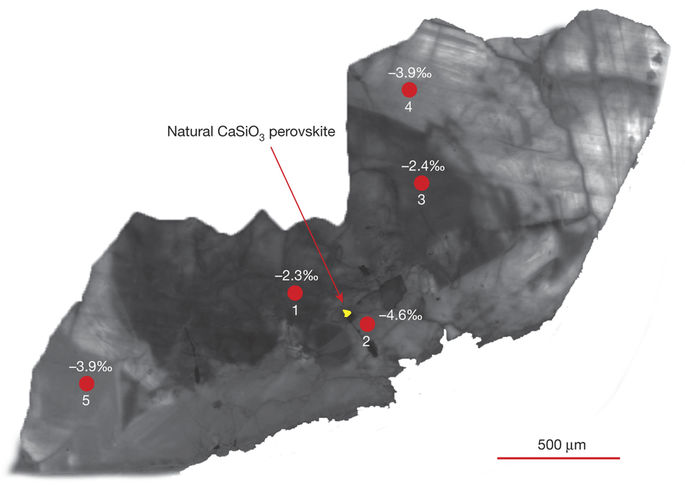Our official English website, www.x-mol.net, welcomes your feedback! (Note: you will need to create a separate account there.)
CaSiO3 perovskite in diamond indicates the recycling of oceanic crust into the lower mantle
Nature ( IF 64.8 ) Pub Date : 2018-03-01 , DOI: 10.1038/nature25972 F. Nestola , N. Korolev , M. Kopylova , N. Rotiroti , D. G. Pearson , M. G. Pamato , M. Alvaro , L. Peruzzo , J. J. Gurney , A. E. Moore , J. Davidson
Nature ( IF 64.8 ) Pub Date : 2018-03-01 , DOI: 10.1038/nature25972 F. Nestola , N. Korolev , M. Kopylova , N. Rotiroti , D. G. Pearson , M. G. Pamato , M. Alvaro , L. Peruzzo , J. J. Gurney , A. E. Moore , J. Davidson

|
Laboratory experiments and seismology data have created a clear theoretical picture of the most abundant minerals that comprise the deeper parts of the Earth’s mantle. Discoveries of some of these minerals in ‘super-deep’ diamonds—formed between two hundred and about one thousand kilometres into the lower mantle—have confirmed part of this picture. A notable exception is the high-pressure perovskite-structured polymorph of calcium silicate (CaSiO3). This mineral—expected to be the fourth most abundant in the Earth—has not previously been found in nature. Being the dominant host for calcium and, owing to its accommodating crystal structure, the major sink for heat-producing elements (potassium, uranium and thorium) in the transition zone and lower mantle, it is critical to establish its presence. Here we report the discovery of the perovskite-structured polymorph of CaSiO3 in a diamond from South African Cullinan kimberlite. The mineral is intergrown with about six per cent calcium titanate (CaTiO3). The titanium-rich composition of this inclusion indicates a bulk composition consistent with derivation from basaltic oceanic crust subducted to pressures equivalent to those present at the depths of the uppermost lower mantle. The relatively ‘heavy’ carbon isotopic composition of the surrounding diamond, together with the pristine high-pressure CaSiO3 structure, provides evidence for the recycling of oceanic crust and surficial carbon to lower-mantle depths.
中文翻译:

金刚石中的 CaSiO3 钙钛矿表明大洋地壳循环进入下地幔
实验室实验和地震学数据为构成地幔较深部分的最丰富的矿物创造了清晰的理论图景。在形成于下地幔约 200 至 1000 公里的“超深”钻石中发现了其中一些矿物质,证实了这幅图片的一部分。一个值得注意的例外是硅酸钙 (CaSiO3) 的高压钙钛矿结构多晶型物。这种矿物——预计是地球上第四丰富的矿物——以前从未在自然界中发现过。作为钙的主要宿主,并且由于其可调节的晶体结构,是过渡带和下地幔中产热元素(钾、铀和钍)的主要汇,因此确定其存在至关重要。在这里,我们报告在来自南非库里南金伯利岩的钻石中发现了钙钛矿结构的 CaSiO3 多晶型物。这种矿物与大约 6% 的钛酸钙 (CaTiO3) 共生。该包裹体的富钛成分表明,其整体成分与玄武质洋壳俯冲到与最上层下地幔深处存在的压力相当的压力一致。周围钻石相对“重”的碳同位素组成,加上原始高压 CaSiO3 结构,为大洋地壳和表层碳循环到下地幔深度提供了证据。该包裹体的富钛成分表明,其整体成分与玄武质洋壳俯冲到与最上层下地幔深处存在的压力相当的压力一致。周围钻石相对“重”的碳同位素组成,加上原始高压 CaSiO3 结构,为大洋地壳和表层碳循环到下地幔深度提供了证据。该包裹体的富钛成分表明,其整体成分与玄武质洋壳俯冲到与最上层下地幔深处存在的压力相当的压力一致。周围钻石相对“重”的碳同位素组成,加上原始高压 CaSiO3 结构,为大洋地壳和表层碳循环到下地幔深度提供了证据。
更新日期:2018-03-01
中文翻译:

金刚石中的 CaSiO3 钙钛矿表明大洋地壳循环进入下地幔
实验室实验和地震学数据为构成地幔较深部分的最丰富的矿物创造了清晰的理论图景。在形成于下地幔约 200 至 1000 公里的“超深”钻石中发现了其中一些矿物质,证实了这幅图片的一部分。一个值得注意的例外是硅酸钙 (CaSiO3) 的高压钙钛矿结构多晶型物。这种矿物——预计是地球上第四丰富的矿物——以前从未在自然界中发现过。作为钙的主要宿主,并且由于其可调节的晶体结构,是过渡带和下地幔中产热元素(钾、铀和钍)的主要汇,因此确定其存在至关重要。在这里,我们报告在来自南非库里南金伯利岩的钻石中发现了钙钛矿结构的 CaSiO3 多晶型物。这种矿物与大约 6% 的钛酸钙 (CaTiO3) 共生。该包裹体的富钛成分表明,其整体成分与玄武质洋壳俯冲到与最上层下地幔深处存在的压力相当的压力一致。周围钻石相对“重”的碳同位素组成,加上原始高压 CaSiO3 结构,为大洋地壳和表层碳循环到下地幔深度提供了证据。该包裹体的富钛成分表明,其整体成分与玄武质洋壳俯冲到与最上层下地幔深处存在的压力相当的压力一致。周围钻石相对“重”的碳同位素组成,加上原始高压 CaSiO3 结构,为大洋地壳和表层碳循环到下地幔深度提供了证据。该包裹体的富钛成分表明,其整体成分与玄武质洋壳俯冲到与最上层下地幔深处存在的压力相当的压力一致。周围钻石相对“重”的碳同位素组成,加上原始高压 CaSiO3 结构,为大洋地壳和表层碳循环到下地幔深度提供了证据。



























 京公网安备 11010802027423号
京公网安备 11010802027423号